Multiobjective Optimization of the Performance and Emissions of a Large Low-Speed Dual-Fuel Marine Engine Based on MNLR-MOPSO
Abstract
:1. Introduction
2. Modeling Methodology
2.1. Establishment and Calibration of the Simulation Model
2.2. Establishment of Multivariate Nonlinear Regression Model Based on SPSS
2.3. Multiobjective Optimization Method
3. Results and Discussion
3.1. Regression Analysis
3.2. Operating Parameter Analysis
3.3. MOPSO Optimization Results
4. Conclusions
- A 1D simulation model established through AVL-BOOST software was developed and validated based on experimental investigation for dual-fuel engine optimization. The pure diesel mode model was first established and then modified into natural gas–diesel dual-fuel mode. The maximum error was 2.5% for the diesel mode and 2.83% for the dual-fuel mode. The trend of the simulation model was consistent with the experimental data, which is suitable for the prediction of performance, combustion, and emission under various working conditions.
- The multivariate nonlinear regression (MNLR) model was implemented using SPSS software, and 112 samples were provided by the 1D simulation model. The of the power, BSFC, NOx emissions, and PFP was greater than 0.98, indicating the accuracy of the regression model and that it can be used for further studies.
- Through analysis of the regression prediction model, it was found that with the increase in intake pressure, the power of the dual-fuel engine increased first and then decreased, while BSFC decreased first and then increased, NOx emissions gradually decreased, and PFP gradually increased. With the increase in intake temperature, the power and PFP of dual-fuel engine gradually decreased, while BSFC and NOx emissions gradually increased. Under the condition of guaranteed fuel injection quality, with the increase in natural gas mass fraction, the power and PFP of the dual-fuel engine gradually increased. The NOx emissions also gradually increased, but the BSFC gradually decreased.
- According to the trade-off relationship between various objectives and parameters of the dual-fuel engine, the regression model was used as a proxy model and the MOPSO optimization algorithm was used to optimize the solution. The optimal value range of the intake pressure, intake temperature, and natural gas mass fraction was optimized, and the optimal value range of intake pressure was 3.6–3.7 bar. The optimal value range of intake temperature was 297.15–297.25 K, and the optimal value range of natural gas mass fraction was 0.8–0.962. On this basis, with high power, low BSFC, and low NOx emissions as the target, the optimal intake pressure was 3.607 bar, the intake temperature was 297.15 K, the natural gas mass fraction was 0.962, the power obtained was 6095.583 kW, and BSFC was 146.389 g/kWh. NOx emissions were 475.658 ppm. Compared with the values before optimization, the power of the dual-fuel engine increased by 0.34%, the BSFC reduced by 0.21%, and the NOx emissions reduced by 39.56%.
Author Contributions
Funding
Institutional Review Board Statement
Informed Consent Statement
Data Availability Statement
Acknowledgments
Conflicts of Interest
References
- Zhu, L.; Li, B.; Li, A.; Ji, W.; Qian, Y.; Lu, X.; Huang, Z. Effects of fuel reforming on large-bore low-speed two-stroke dual fuel marine engine combined with EGR and injection strategy. Int. J. Hydrogen Energy 2020, 45, 29505–29517. [Google Scholar] [CrossRef]
- George, D.G.; Eleftherios, K.D.; Chariklia, G.A.; George, D.G.; Eleftherios, K.D.; Chariklia, G.A. LNG carrier two-stroke propulsion systems: A comparative study of state of the art reliquefaction technologies. Energy 2020, 195, 116997. [Google Scholar] [CrossRef]
- Yu, H.; Duan, S.; Sun, P. Comparative analysis between natural gas/diesel (dual fuel) and pure diesel on the marine diesel engine. J. Eng. Res. 2015, 3. [Google Scholar] [CrossRef]
- Li, Y.; Wang, Q. Research Status of Natural Gas/Diesel Dual Fuel Engine. Chem. Eng. Des. Commun. 2016, 42, 87–88. [Google Scholar]
- Mavrelos, C.; Theotokatos, G. Numerical investigation of a premixed combustion large marine two-stroke dual fuel engine for optimising engine settings via parametric runs. Energy Convers. Manag. 2018, 160, 48–59. [Google Scholar] [CrossRef] [Green Version]
- Stoumpos, S.; Theotokatos, G.; Boulougouris, E.; Vassalos, D.; Lazakis, I.; Livanos, G. Marine dual fuel engine modelling and parametric investigation of engine settings effect on performance-emissions trade-offs. Ocean Eng. 2018, 157, 376–386. [Google Scholar] [CrossRef] [Green Version]
- Abagnale, C.; Cameretti, M.C.; De Simio, L.; Gambino, M.; Iannaccone, S.; Tuccillo, R. Numerical Simulation and Experimental Test of Dual Fuel Operated Diesel Engines. Appl. Therm. Eng. 2014, 65, 403–417. [Google Scholar] [CrossRef]
- Zheng, Z.; Li, C.; Ye, Y.; Liu, T.; Liu, B.; Wu, Z.; Dong, J.; Liu, H.; Yao, M. Numerical Simulation of Clean Combustion Strategy for Low-Pressure Injection Natural Gas Dual-Fuel Marine Engine. J. Combust. Sci. Technol. 2020, 26, 212–218. [Google Scholar]
- Aldawood, A.; Mosbach, S.; Kraft, M. HCCI Combustion Control Using Dual-Fuel Approach: Experimental and Modeling Investigations; SAE: New York, NY, USA, 2012. [Google Scholar]
- Gonca, G.; Sahin, B. Effect of turbo charging and steam injection methods on the performance of a Miller cycle diesel engine (MCDE). Appl. Therm. Eng. 2017, 118, 138–146. [Google Scholar] [CrossRef]
- Zou, F.-K.; Zeng, H.; Wang, H.-Y.; Wang, X.-X.; Xu, Z.-X. Implementation and Parameter Analysis of the Knock Phenomenon of a Marine Dual-Fuel Engine Based on a Two-Zone Combustion Model. Processes 2021, 9, 602. [Google Scholar] [CrossRef]
- Zhou, L.; Song, Y.; Hua, J.; Liu, F.; Wei, H. Effects of miller cycle strategies on combustion characteristics and knock resistance in a spark assisted compression ignition (SACI) engine. Energy 2020, 206, 118119. [Google Scholar] [CrossRef]
- Benajes, J.; Molina, S.; Novella, R.; Belarte, E. Evaluation of massive exhaust gas recirculation and Miller cycle strategies for mixing-controlled low temperature combustion in a heavy duty diesel engine. Energy 2014, 71, 355–366. [Google Scholar] [CrossRef]
- Belgiorno, G.; Dimitrakopoulos, N.; Di Blasio, G.; Beatrice, C.; Tunestål, P.; Tunér, M. Effect of the engine calibration parameters on gasoline partially premixed combustion performance and emissions compared to conventional diesel combustion in a light-duty Euro 6 engine. Appl. Energy 2018, 228, 2221–2234. [Google Scholar] [CrossRef]
- Ji, W.; Li, A.; Lu, X.; Huang, Z.; Zhu, L. Numerical study on NOx and ISFC co-optimization for a low-speed two-stroke engine via Miller cycle, EGR, intake air humidification, and injection strategy implementation. Appl. Therm. Eng. 2019, 153, 398–408. [Google Scholar] [CrossRef]
- Lee, C.-F.; Pang, Y.; Wu, H.; Nithyanandan, K.; Liu, F. An optical investigation of substitution rates on natural gas/diesel dual-fuel combustion in a diesel engine. Appl. Energy 2020, 261, 114455. [Google Scholar] [CrossRef]
- Khanjani, A.; Sobati, M.A. Performance and emission of a diesel engine using different water/waste fish oil (WFO) biodiesel/diesel emulsion fuels: Optimization of fuel formulation via response surface methodology (RSM). Fuel 2021, 288, 119662. [Google Scholar] [CrossRef]
- Şener, R.; Gül, M.Z. Optimization of the combustion chamber geometry and injection parameters on a light-duty diesel engine for emission minimization using multi-objective genetic algorithm. Fuel 2021, 304, 121379. [Google Scholar] [CrossRef]
- Golzari, R.; Zhao, H.; Hall, J.; Bassett, M.; Williams, J.; Pearson, R. Impact of intake port injection of water on boosted downsized gasoline direct injection engine combustion, efficiency and emissions. Int. J. Engine Res. 2021, 22, 295–315. [Google Scholar] [CrossRef]
- Stoumpos, S.; Theotokatos, G. Multiobjective Optimisation of a Marine Dual Fuel Engine Equipped with Exhaust Gas Recirculation and Air Bypass Systems. Energies 2020, 13, 5021. [Google Scholar] [CrossRef]
- Cai, B.; Rui, H.; Zheng, W. Research on Decision Method of EGR Rate of Diesel Engine based on Multi-Objective Optimization. Intern. Combust. Engine Parts 2020, 17, 1–05. [Google Scholar]
- Chongrong, W.U.; Shengli, W.E.I.; Hongrkun, L.U. Research on Multi-Parameter and Multi-Goal Optimization of Diesel Engine Combustion System. Mach. Des. Manuf. 2019, 2, 13–17. [Google Scholar]
- Kamarulzaman, M.K.; Abdullah, A. Multi-Objective Optimization of Diesel Engine Performances and Exhaust Emissions Characteristics of Hermetia Illucens Larvae Oil-Diesel Fuel Blends Using Response Surface Methodology. Energy Sources Part A Recovery Util. Environ. Eff. 2020, 42, 1–14. [Google Scholar] [CrossRef]
- Wang, H.; Gan, H.; Wang, G.; Zhong, G. Emission and Performance Optimization of Marine Four-Stroke Dual-Fuel Engine Based on Response Surface Methodology. Math. Probl. Eng. 2020, 2020, 1–9. [Google Scholar] [CrossRef]
- Sarangi, A.K.; Garner, C.P.; McTaggart-Cowan, G.P.; Davy, M.H.; Hargrave, G.K. The Impact of Intake Pressure On high-EGR Low Temperature Compression Ignition Engine Combustion Using Borescopic Imaging. Int. J. Engine Res. 2020, 22, 2347–2361. [Google Scholar] [CrossRef]
- Teoh, Y.; Huspi, H.; How, H.; Sher, F.; Din, Z.; Le, T.; Nguyen, H. Effect of Intake Air Temperature and Premixed Ratio on Combustion and Exhaust Emissions in a Partial HCCI-DI Diesel Engine. Sustainability 2021, 13, 8593. [Google Scholar] [CrossRef]
- Dai, L.M.; Wang, Q.; Zhang, Z.R.; He, Z.X.; Gao, Z.S. Numerical Simulation of the Combustion and Emissions of HPDI Engine under Different Natural Gas Substitution Rate. Adv. Mater. Res. 2014, 1044–1045, 362–369. [Google Scholar] [CrossRef]
- Jiang, X.; Wei, H.; Zhou, L.; Chen, R. Numerical Study on the Effects of Multiple-Injection Coupled with EGR on Combustion and NOx Emissions in a Marine Diesel Engine. Energy Procedia 2019, 158, 4429–4434. [Google Scholar] [CrossRef]
- Wang, H.; Gan, H.; Theotokatos, G. Parametric investigation of pre-injection on the combustion, knocking and emissions behaviour of a large marine four-stroke dual-fuel engine. Fuel 2020, 281, 118744. [Google Scholar] [CrossRef]
- Two-stroke Project Guides. Available online: https://marine.man-es.com/two-stroke/project-guides (accessed on 23 December 2017).
- Hongliang, Y.U. Numerical Research of Combustion Process in Two-Stroke Low-speed LNG/Diesel Marine Dual-Fuel Engine; Dalian Maritime University: Dalian, China, 2020. [Google Scholar]
- List, A. AVL BOOST Users’ Guides; AVL List GmbH: Graz, Austria, 2016. [Google Scholar]
- Woschni, G. A Universally Applicable Equation for the Instantaneous Heat Transfer Coefficient in the Internal Combustion Engine; SAE: New York, NY, USA, 2018; pp. 3065–3083. [Google Scholar]
- Chuan, R. Numerical Study on the Performance of Dual-Fuel Marine Engine; Dalian Maritime University: Dalian, China, 2013. [Google Scholar]
- Wang, G. Simulation on Micro-Pilot Injection Strategy of Marine Medium-Speed Dual Fuel Engine; Wuhan University of Technology: Wuhan, China, 2017. [Google Scholar]
- Liu, H.; Zhang, H.; Wang, H.; Zou, X. Impact of Air Intake Components on NOx Emissions in Low-Speed Marine Diesel Engine. J. Combust. Sci. Technol. 2017, 23, 313–319. [Google Scholar]
- Song, X. Urban Population Growth Model Based on SPSS Regression Analysis. In Proceedings of the 2018 13th International Conference on Computer Science & Education (ICCSE), Colombo, Sri Lanka, 8–11 August 2018; pp. 1–7. [Google Scholar]
- Zhang, K.; Li, W.; Han, Y.; Geng, Z.; Chu, C. Production capacity identification and analysis using novel multivariate nonlinear regression: Application to resource optimization of industrial processes. J. Clean. Prod. 2021, 282, 124469. [Google Scholar] [CrossRef]
- Liu, J.; Zhao, H.; Wang, J.; Zhang, N. Optimization of the injection parameters of a diesel/natural gas dual fuel engine with multi-objective evolutionary algorithms. Appl. Therm. Eng. 2019, 150, 70–79. [Google Scholar] [CrossRef]
- Ji, C.; Wang, H.; Shi, C.; Wang, S.; Yang, J. Multi-Objective Optimization of Operating Parameters for a Gasoline Wankel Rotary Engine by Hydrogen Enrichment. ENERGY Convers. Manag. 2021, 229, 113732. [Google Scholar] [CrossRef]
- Feng, Q.; Li, Q.; Quan, W.; Pei, X. Overview of Multi-Objective Particle Swarm Optimization Algorithm. Chin. J. Eng. 2021, 43, 745–753. [Google Scholar]
- Lee, P.P.; Sin, C.N. Improved Efficiency of MOPSO with Adaptive Inertia Weight and Dynamic Search Space. In Proceedings of the GECCO 2018 Genetic and Evolutionary Computation Conference Companion, Kyoto, Japan, 15–19 July 2018; pp. 1910–1913. [Google Scholar]
- Tuppadung, Y.; Kurutach, W. Comparing nonlinear inertia weights and constriction factors in particle swarm optimization. Int. J. Knowledge-based Intell. Eng. Syst. 2011, 15, 65–70. [Google Scholar] [CrossRef]
- Van den Bergh, F.; Engelbrecht, A.P. A study of particle swarm optimization particle trajectories. Inf. Sci. 2006, 176, 937–971. [Google Scholar] [CrossRef]
- Huang, Y.; Ma, F. Intelligent regression algorithm study based on performance and NOx emission experimental data of a hydrogen enriched natural gas engine. Int. J. Hydrogen Energy 2016, 41, 11308–11320. [Google Scholar] [CrossRef]
- Wang, H.; Ji, C.; Shi, C.; Ge, Y.; Wang, S.; Yang, J. Development of cyclic variation prediction model of the gasoline and n-butanol rotary engines with hydrogen enrichment. Fuel 2021, 299, 120891. [Google Scholar] [CrossRef]
- Kakati, D.; Roy, S.; Banerjee, R. Development of an artificial neural network based virtual sensing platform for the simultaneous prediction of emission-performance-stability parameters of a diesel engine operating in dual fuel mode with port injected methanol. Energy Convers. Manag. 2019, 184, 488–509. [Google Scholar] [CrossRef]
- Chen, Z.; Li, T.; Wang, B.; Zheng, M. Influence of Intake Pressure on Diesel Micro Ignition Ethanol Engine. SHIP Eng. 2017, 39, 40–43. [Google Scholar]
- Xu, G.; Jia, M.; Li, Y.; Xie, M.; Su, W. Multi-objective optimization of the combustion of a heavy-duty diesel engine with low temperature combustion (LTC) under a wide load range: (II) Detailed parametric, energy, and exergy analysis. Energy 2017, 139, 247–261. [Google Scholar] [CrossRef]
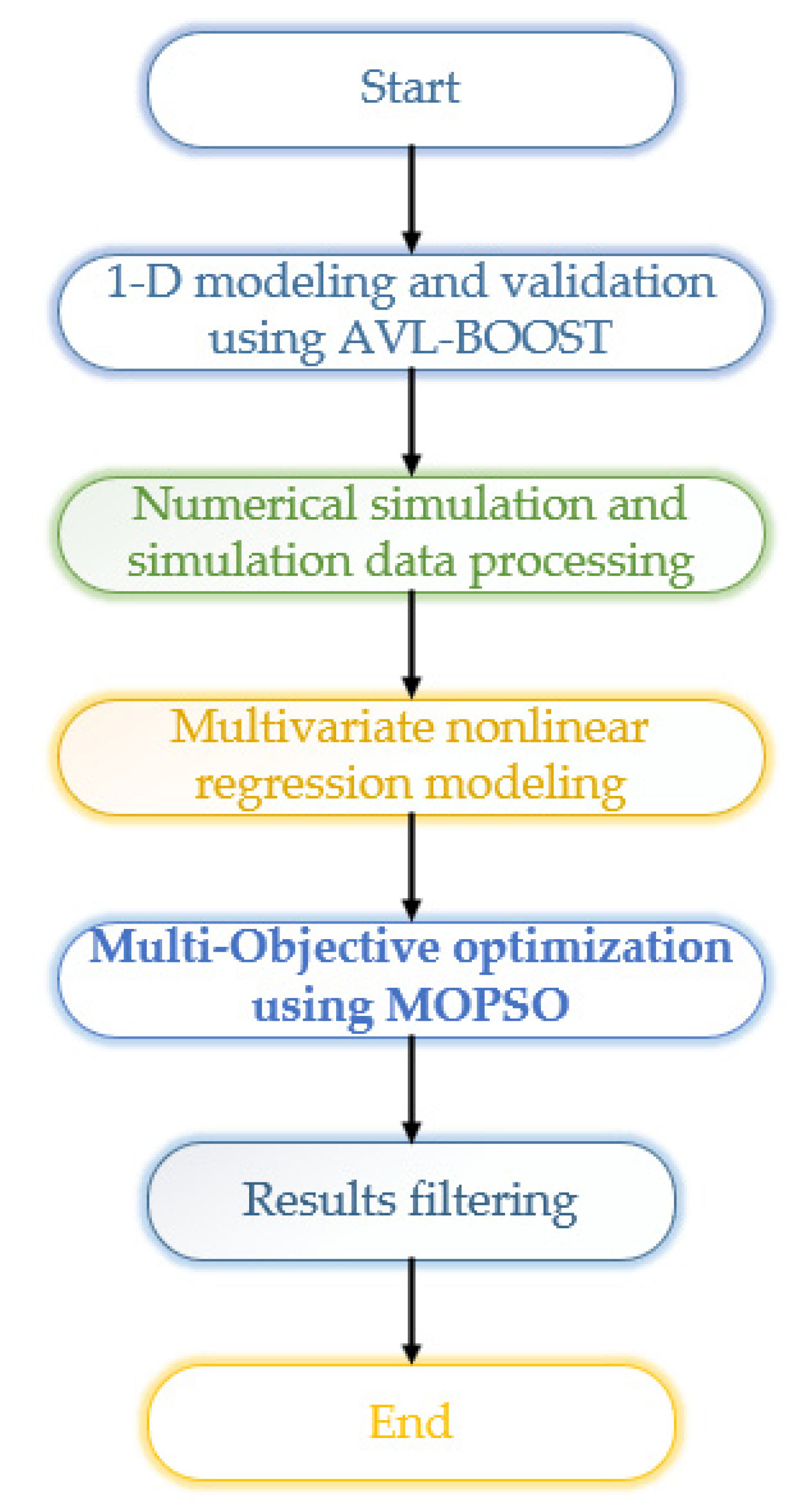
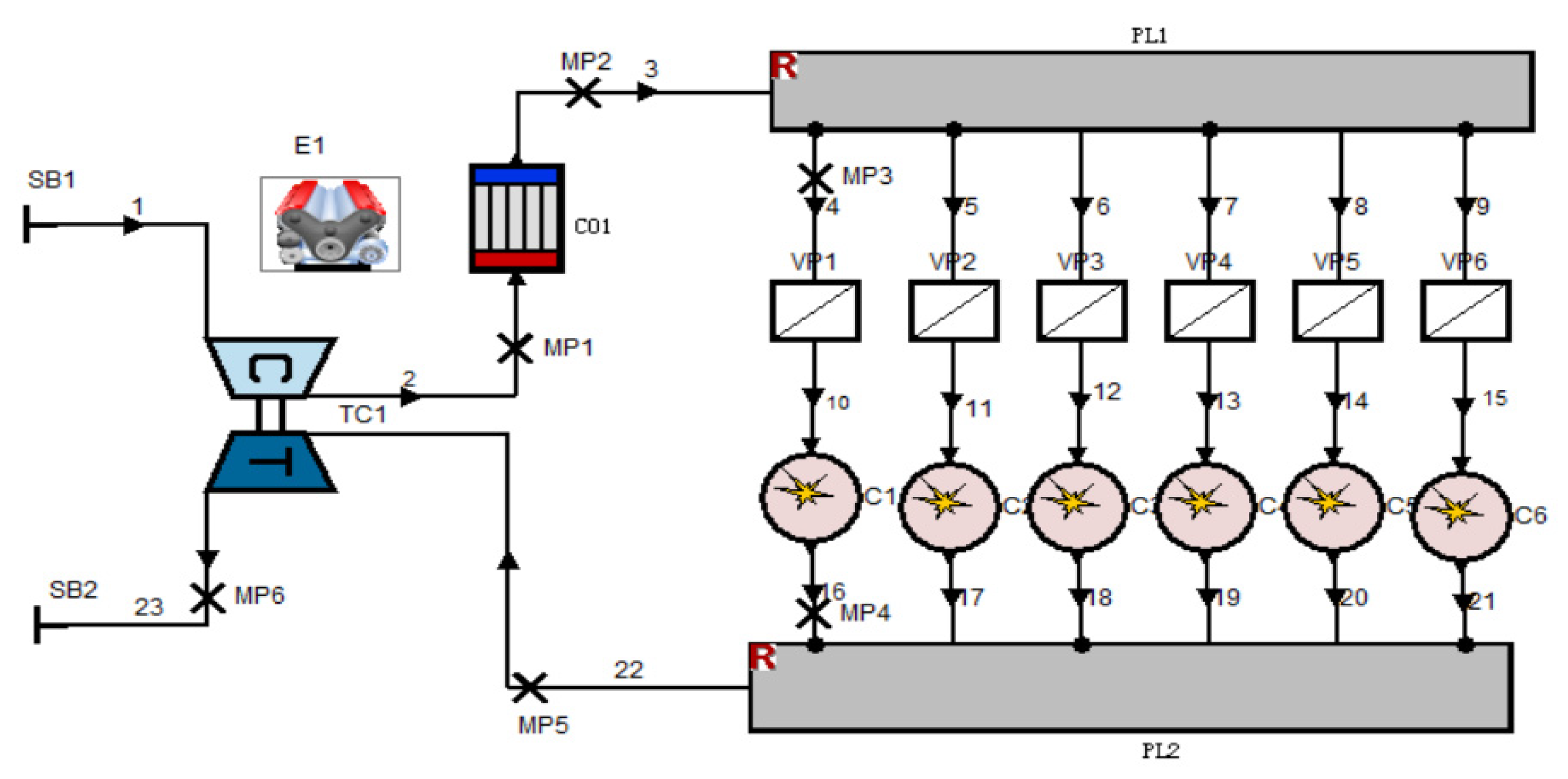
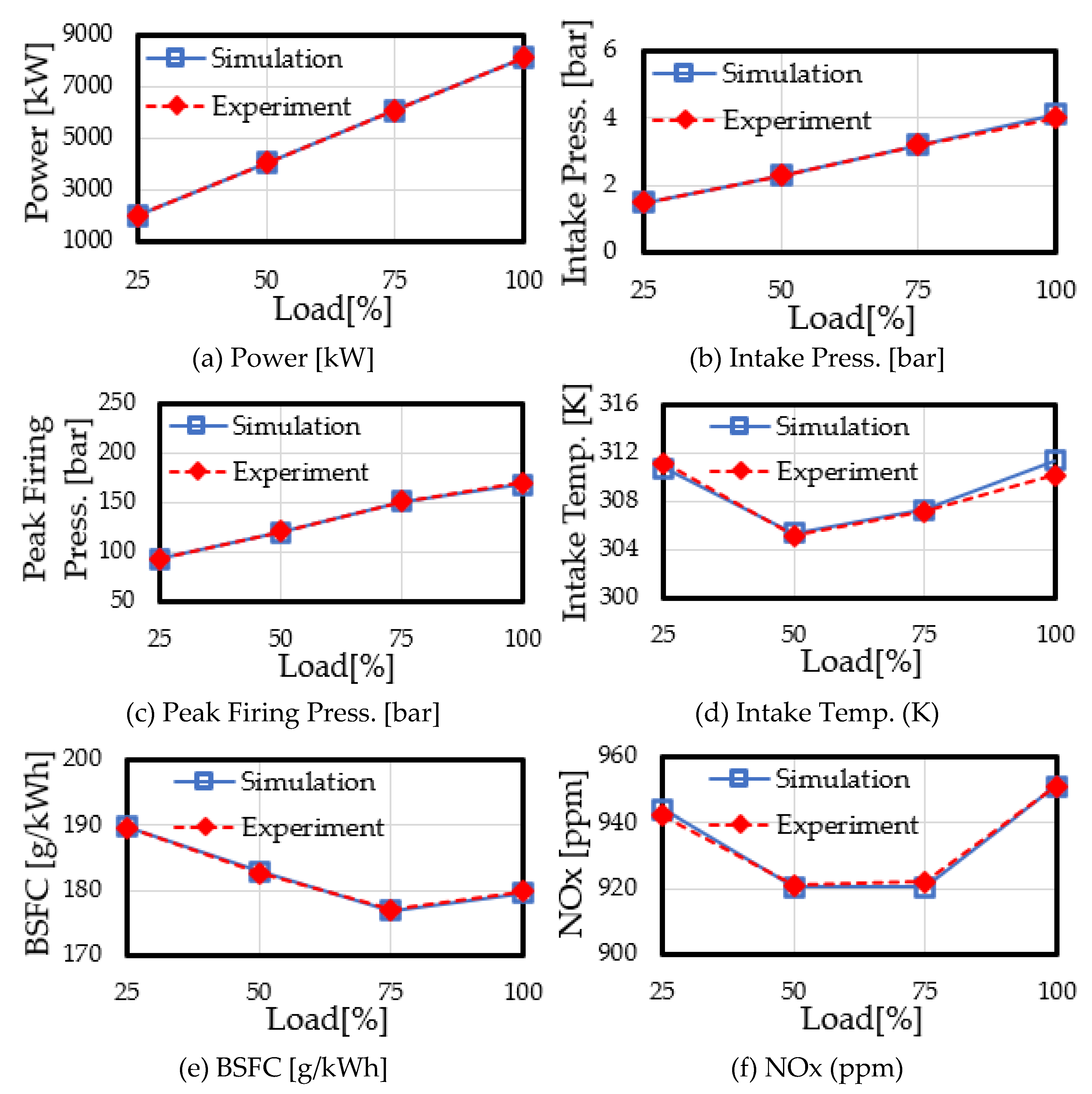

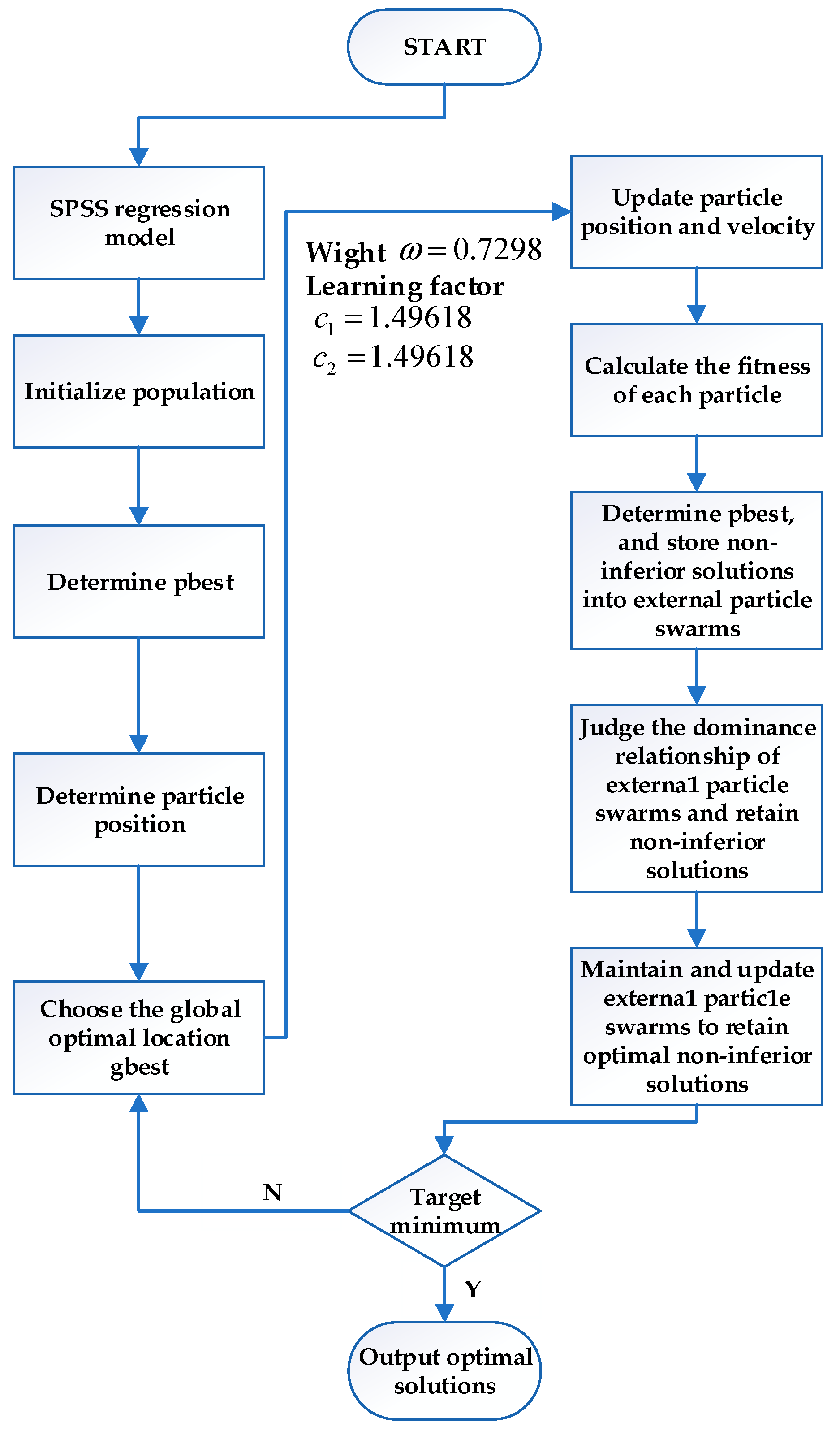
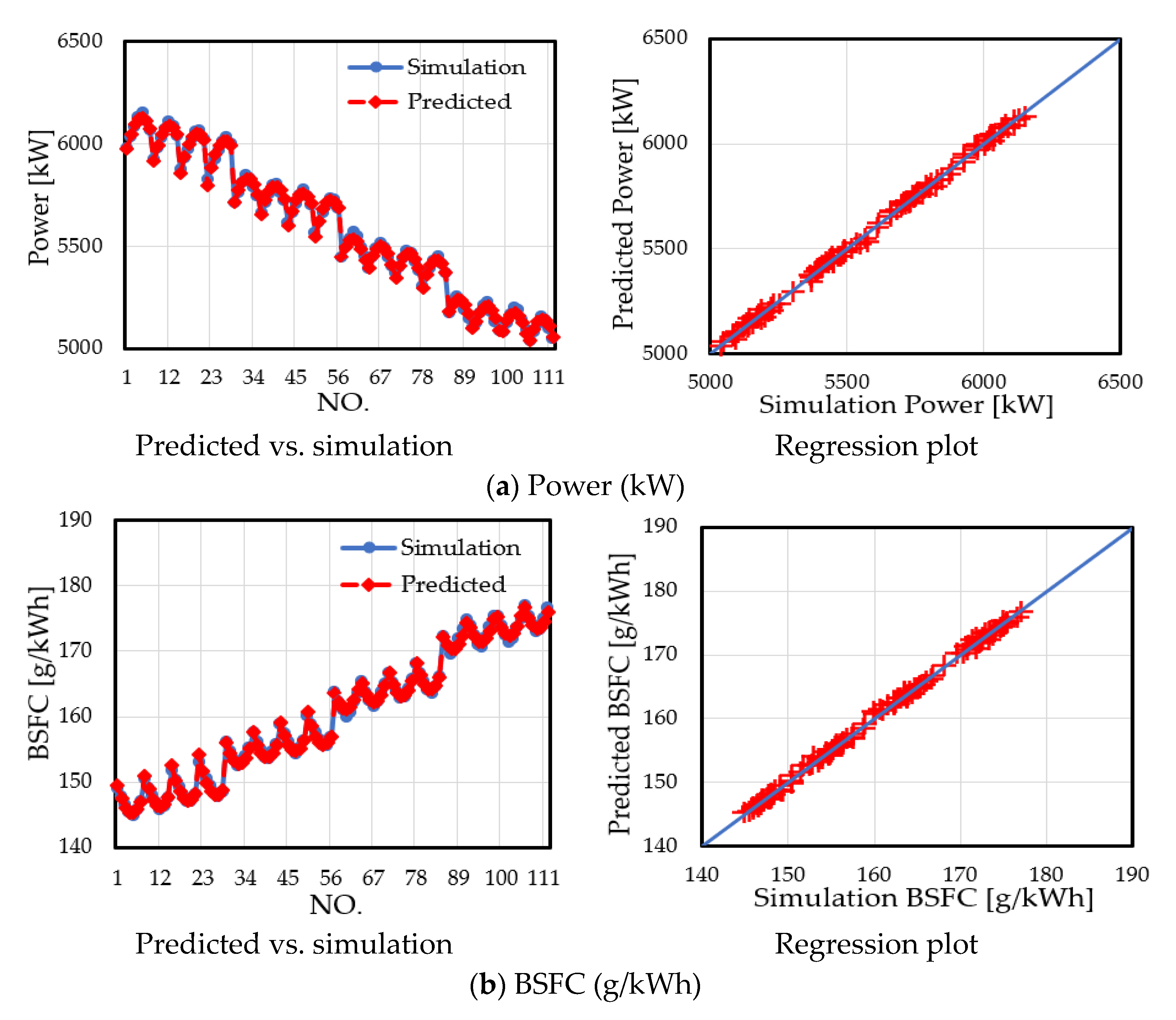
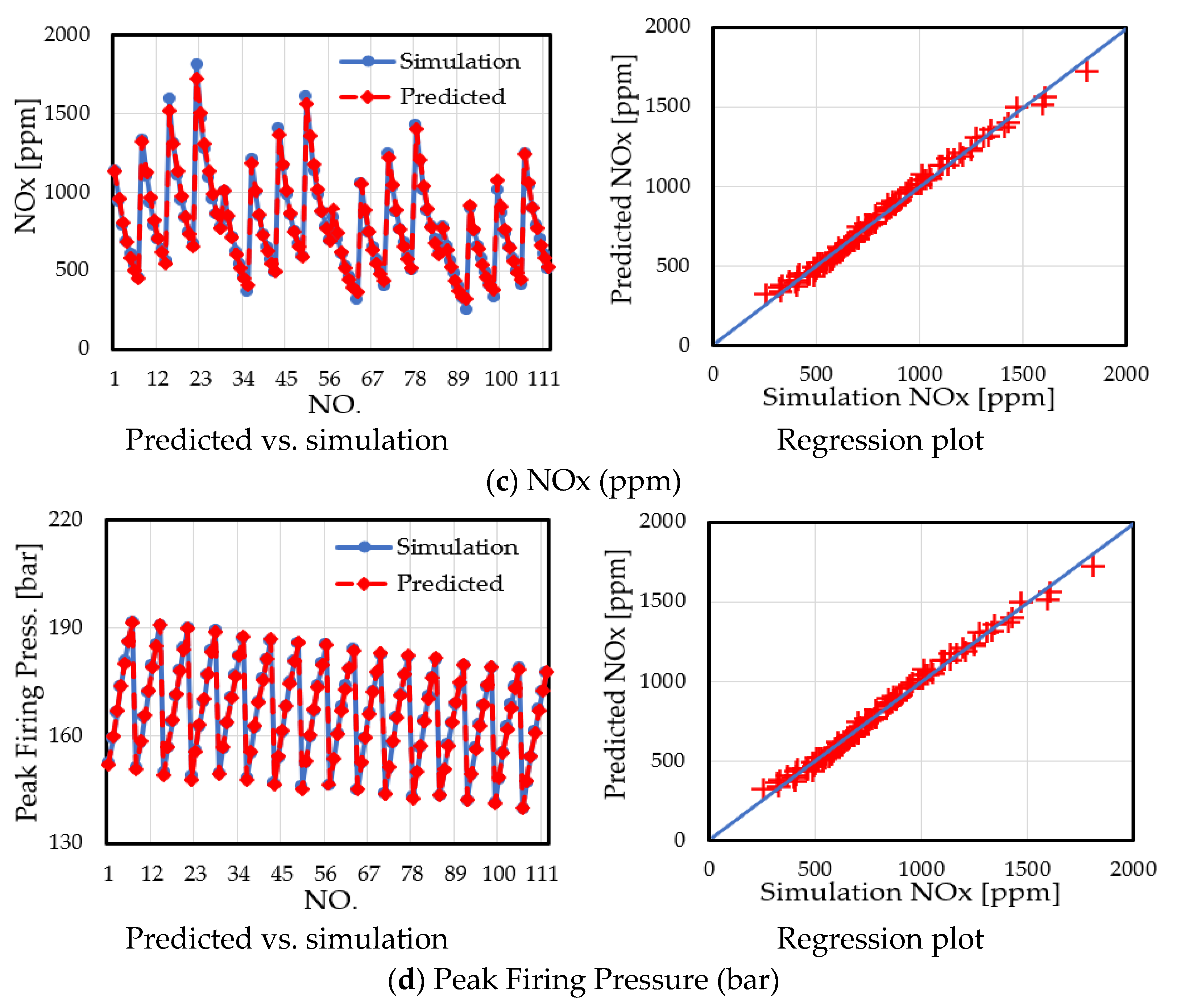
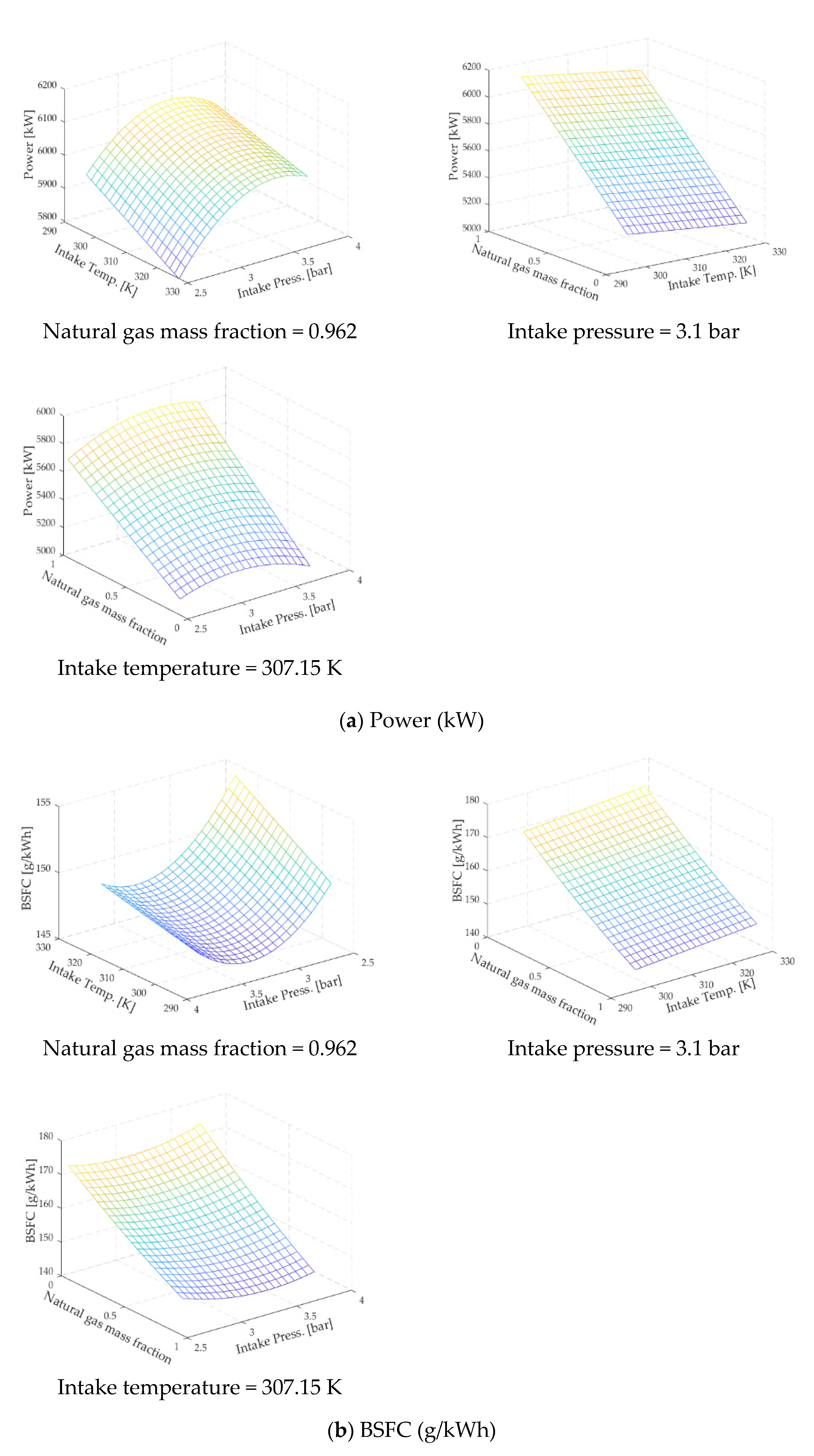
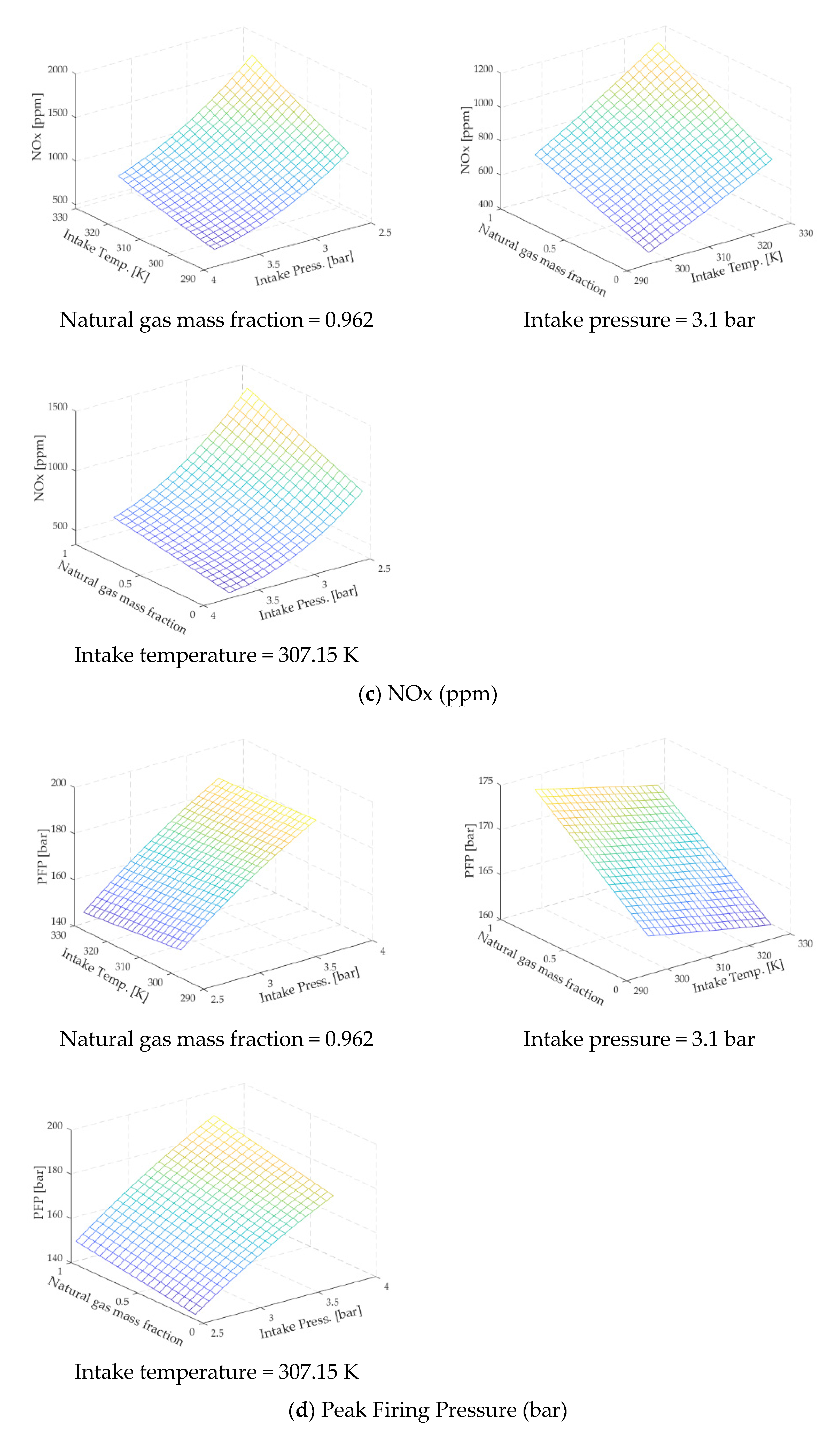
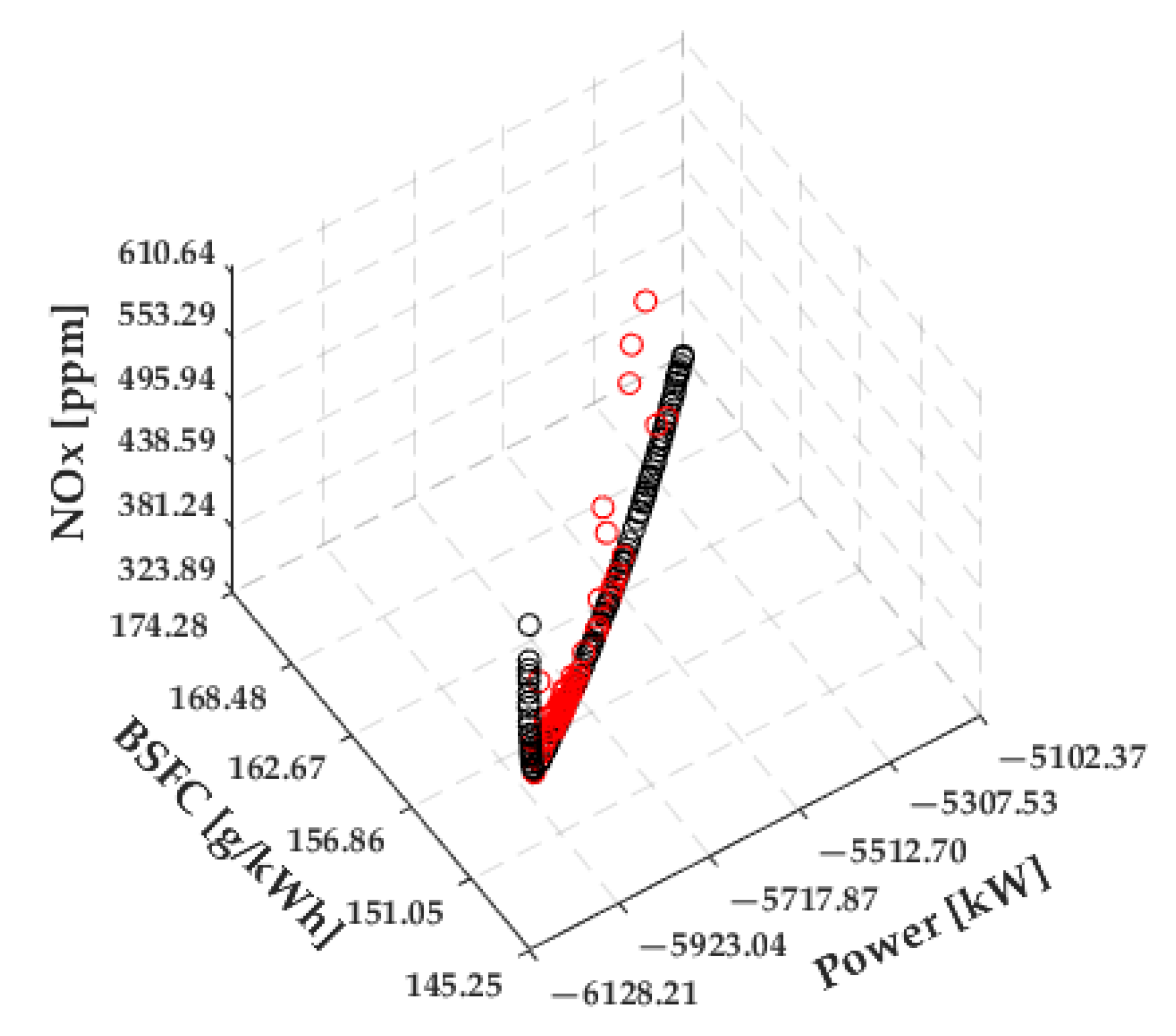


| Engine Parameters | Unit | Values |
|---|---|---|
| Cylinder number | - | 6 |
| Bore | mm | 500 |
| Stroke | mm | 2000 |
| Power | kW | 8100 |
| Speed | rpm | 108 |
| Fire order | - | 1-5-3-4-2-6 |
| NO. | Symbols | Element |
|---|---|---|
| 1 | SB1 | Intake boundary |
| 2 | SB2 | Exhaust boundary |
| 3 | E1 | Engine |
| 4 | TC1 | Turbocharger |
| 5 | CO1 | Cooler |
| 6 | MP1-6 | Measuring point |
| 7 | PL1 | Intake manifold |
| 8 | PL2 | Exhaust manifold |
| 9 | VP1-6 | Scavenge box |
| 10 | C1-6 | Cylinder |
| 11 | 1-23 | Pipe |
| NO. | 1 | 2 | 3 | 4 | |
|---|---|---|---|---|---|
| Load (%) | - | 25 | 50 | 75 | 100 |
| Speed (rpm) | - | 68 | 85.7 | 98.1 | 108 |
| Power (kW) | - | 2025 | 4050 | 6075 | 8100 |
| Exhaust Gas Temperature (°C) | Cylinder out | 235 | 286 | 312 | 375 |
| Before T/C | 286 | 352 | 399 | 472 | |
| After T/C | 214 | 223 | 213 | 240 | |
| T/C speed (rpm) | - | 8929 | 13,528 | 16,570 | 18,777 |
| Test room | Temperature (°C) | 26 | 25.6 | 25.7 | 25.1 |
| Engine Load (%) | 100 | 75 | 50 | 25 |
|---|---|---|---|---|
| Mode | Diesel Mode Error (%) | |||
| Power (kW) | 0.09 | −0.03 | −0.15 | −0.1 |
| Intake Pressure (bar) | 2.5 | 0 | −0.43 | 0 |
| Peak Firing Pressure (bar) | −1.3 | −0.57 | −0.28 | −0.77 |
| BSFC (g/kWh) | −0.09 | −0.1 | 0.14 | 0.07 |
| Intake Temperature (K) | 0.38 | 0.06 | 0.08 | −0.13 |
| NOx (ppm) | −0.02 | −0.15 | −0.07 | 0.2 |
| Engine Load (%) | 100 | 75 | 50 | 25 |
|---|---|---|---|---|
| Mode | Gas Mode Error (%) | |||
| Power (kW) | 0.36 | −0.06 | −0.14 | 0.1 |
| Intake Pressure (bar) | 0 | 0 | −0.9 | −0.71 |
| Peak Firing Pressure (bar) | 0.17 | −0.05 | 0.13 | −2.83 |
| BSFC (g/kWh) | 0.8 | 0.08 | 0.14 | 0.17 |
| Intake Temperature (K) | −0.02 | 0.11 | 0.01 | 0.21 |
| NOx (ppm) | 0.83 | 0.5 | 0.88 | 0.42 |
| NO. | Intake Pressure (bar) | Intake Temperature (K) | Natural Gas Mass Fraction | Power (kW) | BSFC (g/kWh) | NOx (ppm) | Peak Firing Pressure (bar) |
|---|---|---|---|---|---|---|---|
| 1 | 2.5 | 297.15 | 0.962 | 5979.29 | 149.09 | 1135.26 | 152.42 |
| 2 | 2.7 | 297.15 | 0.962 | 6032.21 | 147.78 | 938.87 | 159.26 |
| 3 | 2.9 | 297.15 | 0.962 | 6082.17 | 146.57 | 793.10 | 166.51 |
| 4 | 3.1 | 297.15 | 0.962 | 6128.70 | 145.45 | 686.18 | 173.85 |
| 5 | 3.3 | 297.15 | 0.962 | 6151.23 | 144.92 | 608.36 | 180.77 |
| 6 | 3.5 | 297.15 | 0.962 | 6111.25 | 145.87 | 533.98 | 186.21 |
| 7 | 3.7 | 297.15 | 0.962 | 6064.91 | 146.98 | 459.65 | 191.50 |
| 8 | 2.5 | 307.15 | 0.962 | 5926.61 | 150.41 | 1332.67 | 151.18 |
| 9 | 2.7 | 307.15 | 0.962 | 5979.05 | 149.09 | 1103.79 | 157.96 |
| ⋮ | ⋮ | ⋮ | ⋮ | ⋮ | ⋮ | ⋮ | ⋮ |
| 109 | 3.1 | 327.15 | 0.062 | 5155.28 | 172.92 | 786.25 | 161.25 |
| 110 | 3.3 | 327.15 | 0.062 | 5142.20 | 173.36 | 701.28 | 167.36 |
| 111 | 3.5 | 327.15 | 0.062 | 5096.41 | 174.92 | 611.44 | 172.54 |
| 112 | 3.7 | 327.15 | 0.062 | 5049.04 | 176.56 | 514.79 | 177.47 |
| Parameter | Estimation | Standard Error | 95% Confidence Interval | |
|---|---|---|---|---|
| Lower Limit | Upper Limit | |||
| a | 6431.583340 | 1336.381482 | 3780.877006 | 9082.289673 |
| b | 817.122254 | 110.896242 | 597.160083 | 1037.084425 |
| c | −13.120762 | 8.391915 | −29.766086 | 3.524562 |
| d | 900.792557 | 116.437965 | 669.838406 | 1131.746708 |
| e | −269.509686 | 9.638417 | −288.627441 | −250.391931 |
| f | 0.003198 | 0.013356 | −0.023293 | 0.029688 |
| g | −22.074143 | 14.839339 | −51.507900 | 7.359615 |
| h | 2.624122 | 0.298635 | 2.031780 | 3.216464 |
| i | −1.379366 | 0.356143 | −2.085773 | −0.672958 |
| j | 165.728262 | 9.954509 | 145.983540 | 185.472985 |
| Source | Quadratic Sum | Degree of Freedom | Mean Square |
|---|---|---|---|
| Regression | 3,502,751,999.441904 | 10.000000 | 350,275,199.944190 |
| Residual | 20,376.532796 | 102.000000 | 199.769929 |
| Uncorrected total | 3,502,772,375.974700 | 112.000000 | - |
| Corrected total | 12,132,592.385299 | 111.000000 | - |
| Dependent variable: y1 | |||
| a R2 = 1 − (Sum of squares of residuals)/(Correct the sum of squares) = 0.998. | |||
| Intake Pressure (bar) | Intake Temperature (K) | Natural Gas Mass Fraction | Power (kW) | BSFC (g/kWh) | NOx (ppm) |
|---|---|---|---|---|---|
| 3.700 | 297.245 | 0.893 | 6001.997 | 148.814 | 445.591 |
| 3.700 | 297.150 | 0.909 | 6018.877 | 148.400 | 446.920 |
| 3.700 | 297.150 | 0.919 | 6030.272 | 148.122 | 448.399 |
| 3.700 | 297.150 | 0.933 | 6044.708 | 147.770 | 450.271 |
| 3.700 | 297.150 | 0.939 | 6051.243 | 147.612 | 451.118 |
| 3.698 | 297.161 | 0.949 | 6062.025 | 147.347 | 452.994 |
| 3.700 | 297.150 | 0.960 | 6073.935 | 147.064 | 454.054 |
| 3.685 | 297.305 | 0.962 | 6078.820 | 146.918 | 458.815 |
| 3.663 | 297.150 | 0.962 | 6084.079 | 146.756 | 462.045 |
| 3.641 | 297.181 | 0.962 | 6088.657 | 146.610 | 467.393 |
| 3.607 | 297.150 | 0.962 | 6095.583 | 146.389 | 475.658 |
Publisher’s Note: MDPI stays neutral with regard to jurisdictional claims in published maps and institutional affiliations. |
© 2021 by the authors. Licensee MDPI, Basel, Switzerland. This article is an open access article distributed under the terms and conditions of the Creative Commons Attribution (CC BY) license (https://creativecommons.org/licenses/by/4.0/).
Share and Cite
Cong, Y.; Gan, H.; Wang, H.; Hu, G.; Liu, Y. Multiobjective Optimization of the Performance and Emissions of a Large Low-Speed Dual-Fuel Marine Engine Based on MNLR-MOPSO. J. Mar. Sci. Eng. 2021, 9, 1170. https://doi.org/10.3390/jmse9111170
Cong Y, Gan H, Wang H, Hu G, Liu Y. Multiobjective Optimization of the Performance and Emissions of a Large Low-Speed Dual-Fuel Marine Engine Based on MNLR-MOPSO. Journal of Marine Science and Engineering. 2021; 9(11):1170. https://doi.org/10.3390/jmse9111170
Chicago/Turabian StyleCong, Yujin, Huibing Gan, Huaiyu Wang, Guotong Hu, and Yi Liu. 2021. "Multiobjective Optimization of the Performance and Emissions of a Large Low-Speed Dual-Fuel Marine Engine Based on MNLR-MOPSO" Journal of Marine Science and Engineering 9, no. 11: 1170. https://doi.org/10.3390/jmse9111170
APA StyleCong, Y., Gan, H., Wang, H., Hu, G., & Liu, Y. (2021). Multiobjective Optimization of the Performance and Emissions of a Large Low-Speed Dual-Fuel Marine Engine Based on MNLR-MOPSO. Journal of Marine Science and Engineering, 9(11), 1170. https://doi.org/10.3390/jmse9111170







